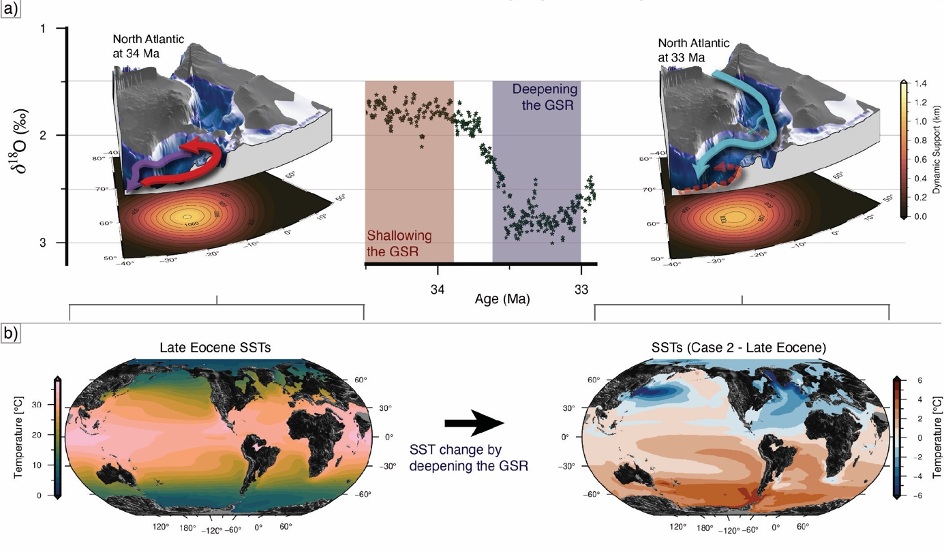The Earth’s climate significantly cooled ~34 million years ago, between the geological epochs of the Eocene and Oligocene (also referred to as the Eocene-Oligocene transition). Previously this climatic shift was attributed to decreasing atmospheric CO2 concentrations and/or changes in oceans such as the Southern Ocean or the Tethys Seaway. However, paleogeography (the study of past geography) in the northern hemisphere and past atmospheric CO2 concentrations hinted that something else was at play.

To unravel this, an interdisciplinary team led by UiO postdoctoral researcher Eivind Straume (now at UT Austin) used an Earth System Model (the NorESM-F) to simulate the climatic impact of ocean depth changes to several key locations in the world’s oceans. The results from these simulations show that changes in the seaways between the Atlantic and Arctic Oceans had a large impact on climate variations 34 million years ago, and may have even influenced the inception of the Southern Hemisphere glaciations.
They modelled changes in the depth of the ocean connection between the Atlantic and Arctic oceans, including in the region of the Greenland-Scotland Ridge (GSR in Figure 2). The model revealed an interplay of depth variation in the North Atlantic and oceanic circulation (including overturning patterns, freshwater influx from the Arctic, and heat transport). Before the Eocene-Oligocene transition (~34 Ma) a relatively shallow Greenland-Scotland Ridge lead to cooling of the southern hemisphere and warming of the northern hemisphere. After the transition (~34-33 Ma), there was a deepening of the seafloor around the ridge, which led to cooling of the Northern Hemisphere. This connection is important because, combined with the effect of decreasing atmospheric CO2, it may explain a scenario proposed from geological temperature proxies that the Southern Hemisphere cooled before the Northern Hemisphere around the Eocene-Oligocene transition.

But what caused this relatively sudden (on geological timescales) change in vertical motion of the submarine ridge? The authors propose that deep-rooted volcanism, known as a mantle plume, in the North Atlantic region (which is still going on Iceland today) modified the depth of this North Atlantic seaway. The authors suggest that pulsations in the hot mantle located below Iceland modified the depth of a shallow sea between Greenland and Eurasia (the Greenland–Scotland Ridge in the North Atlantic), which affected the Atlantic overturning circulation (which also includes the Gulf Stream), and influenced the global ocean heat transport on either side of the climate transition. This exciting study represents a truly connected Earth system; in both space and time, and between the geosphere, hydrosphere and atmosphere.
Publication details Straume Eivind O., Aleksi Nummelin, Carmen Gaina and Kerim H. Nisancioglu (2022) Climate transition at the Eocene–Oligocene influenced by bathymetric changes to the Atlantic–Arctic oceanic gateways. Proceedings of the National Academy of Sciences (PNAS) v119 https://doi.org/10.1073/pnas.2115346119




